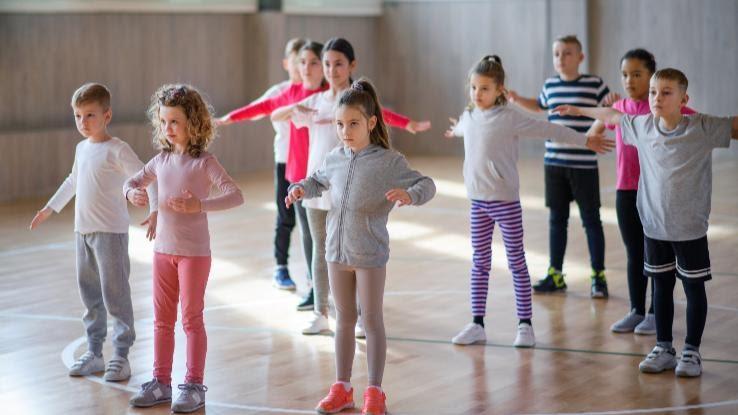Non Locomotor Movements: Skills & Examples

As you probably know, not all exercises have the same impact. For example, there’s a difference between non-locomotor and locomotor movements. Developing the former is particularly important for children since these skills translate to a wide array of everyday actions and recreational activities. But non-locomotor skills are also essential for older adults who want to remain physically independent and active.
What Are Non-Locomotor Movements?
The simplest definition? A non-locomotor movement is a movement in which the body doesn’t travel; in other words, it can be performed while staying in the same space. Some examples include bending, twisting, and stretching. Locomotor skills, by contrast, are movements that cover distances, such as running, walking, and leaping. Essentially, if, after the movement, you end up in a different place from where you started, it’s a locomotor movement. If you’re in the same spot after completing the movement, it’s non-locomotor.

According to Dr. Shannon S.D. Bredin of the University of British Columbia, non-locomotor skills “form the basis of recreational physical activity, specialized sports, or games, and influence activity preference, self-concept and future physical competence.” That is, not only can they help improve one’s balance or flexibility, but they’re also a great way to form a foundation for a huge array of sports, from dance and martial arts to track and gymnastics.
As mentioned above, non-locomotor skills can also be a great way for kids to learn how to control their bodies at a young age. Not to mention, non-locomotor movements can help folks of all ages develop spatial awareness skills.
Non-Locomotor Skills for Elementary School Children
As Dr. Bredin points out, children who practice — and, eventually, master — different non-locomotor skills from a young age are more likely to remain active as they grow. By developing skills like balance, flexibility, and body awareness early on, they’ll have the skills they need to excel in sports and recreational activities.

The most important non-locomotor movements to encourage elementary school-aged kids include:
- Balancing and Swaying: Being able to evenly distribute or shift weight in a variety of positions provides a great groundwork for sports like gymnastics, martial arts, and dancing.
- Bending and Curling: Bending can help increase and maintain flexibility for a variety of sports and everyday activities. Curling — the type of motion used to do a sit-up — can increase strength and is a good foundation for rowing and other machine-based workout regimens.
- Stretching: Stretching is a foundational skill that’s great for warming up before almost any sport. Getting into the habit of stretching can promote flexibility, prevent injury, and lead to an interest in, and aptitude for, activities like yoga.
- Pushing and Pulling: Both are great ways to develop arm strength and are useful skills in both fitness and everyday life.
- Swinging: Swinging refers to the ability to move a body part — either side-to-side or back-and-forth. It’s useful in both developing spatial awareness and for activities like aerobics.
- Turning and Twisting: Turning refers to rotating the body on an axis, while twisting is rotating a part of the body around its axis. Both are useful for sports like gymnastics, dancing, and tumbling.
There are a variety of ways to help kids develop these skills, either at home or in a classroom setting. Use them to warm up for a team sport or turn them into games of their own.
Non-Locomotor Skills for Older Kids and Young Adults
As kids get the hang of basic non-locomotor skills, it’s important to make sure they keep developing said skills as they grow. That’s where the importance of extracurricular activities, such as sports, comes in. Even outside of organized sports, however, there are plenty of ways to help older kids develop.

These can be done with some equipment or tools, or with the body alone. Some examples include:
- Jumping with pogo sticks
- Hula hooping
- Walking on a balance beam
- Jumping rope
- Lifting and curling weights
- Catching and throwing
- Jumping on a trampoline
- Yoga
- Practicing basic gymnastics and tumbling
- Archery
- Aerobics
Once kids reach middle school, they’ll likely begin combining non-locomotor and locomotor movements, as both are pivotal to a variety of sports and activities. If you’re a teacher, try to assess your students from afar in order to spot any areas in which particular students may need more development. You can then assign students either individual or group exercises in accordance with which areas need improvement.
Importance of Non-Locomotor Movements for Adults and Seniors
The importance of non-locomotor movement skills becomes even more crucial as we age, as they can often make all the difference when it comes to how physically independent we’ll remain as seniors. Even if you aren’t able to shoot hoops like you once did, it’s important to practice some more fundamental movements.

“You always want to keep your goals and current or desired lifestyle in the back of your mind,” says Katherine Wilson, D.P.T., a physical therapist at the Hospital for Special Surgery in New York City. “Then, your exercises or daily routines should coincide with those goals.” According to SilverSneakers, there are several workouts that older adults should perform every day. From tandem walking and push-pull combos to rotational squats, these non-strenuous movements can help older folks maintain strength and agility, even as these movements get naturally more difficult with age.





